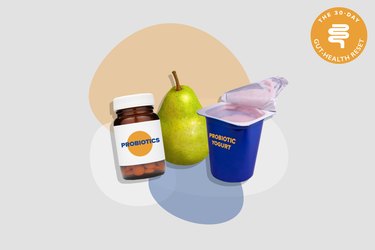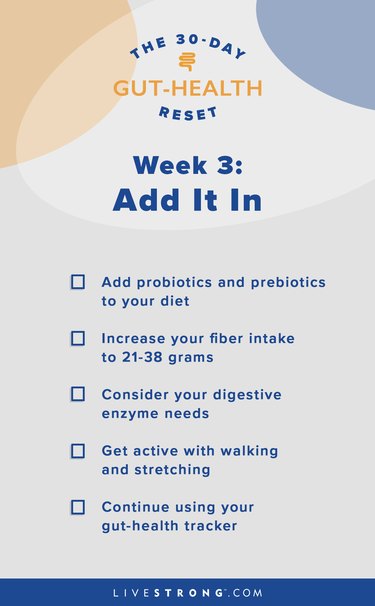
If you want your gut to thrive, it's not just about what you don't do — such as avoiding foods and activities that cause GI distress, as you learned in Week 2 — it's also about what you do do. (Pun absolutely intended.)
It's important to give your digestive system the good stuff, like gut-friendly foods and lower-intensity workouts, so that's the focus of Week 3 of our 30-Day Gut-Health Reset.
"It's encouraging the gut to be able to digest properly," says Vincent Pedre, MD, author of Happy Gut and creator of the 28-Day Happy Gut Cleanse and Happy Gut app.
That encouragement involves probiotics and prebiotics, finding just-right-for-you workouts and potentially supplementing with digestive enzymes to get on the path to good gut health.
Your Goals for Week 3
- Add probiotics and prebiotics to your diet
- Up your fiber intake
- Consider your digestive enzyme needs
- Get active with walking and stretching
- Continue using your gut-health tracker from Week 1
New to the challenge? Click here to get all the details on the 30-day program.
Goal 1: Pair Probiotics and Prebiotics for a Healthier Gut
Inside your gut, there's an ecosystem of bacteria called your gut microbiome, according to the Mayo Clinic. You want the balance of good-for-your-gut and not-so-good species to be just right — when your microbiome is healthy, you're healthy. And eating at least one serving a day of foods that are rich in probiotics and prebiotics supports those good bacteria, Dr. Pedre says.
Probiotics are live organisms found in many foods we eat, according to the National Center for Complementary and Integrative Health (NCCIH). "Probiotics help to restore and heal the gut lining," Dr. Pedre says, and they can help with diarrhea, constipation and other GI symptoms. Good sources of probiotics include:
- Sauerkraut
- Kimchi
- Pickles
- Kombucha
- Apple cider vinegar
- Greek yogurt
- Kefir
- Miso soup
- Blue, cheddar, Gouda or mozzarella cheese
- Tempeh
Prebiotics, on the other hand, are found in fiber-rich fruits and vegetables. These foods serve an important role in the gut: They're fuel for probiotics, notes the Mayo Clinic. Good sources of prebiotics include:
- Bananas
- Jerusalem artichokes
- Chicory root
- Dandelion greens
- Leeks
- Garlic
- Onions
- Whole grains
- Honey
- Asparagus
A Note on Supplements
Both probiotics and prebiotics are available as supplements, but whenever possible, aim to get them through your diet, per the MD Anderson Cancer Center. That way, your body can more easily digest and use them. Plus, you'll get the other nutritional benefits of the foods you're eating.
Goal 2: Include More Fiber in Your Diet
Fiber — the part of fruits, vegetables, whole grains and legumes that your body can't break down and is passed through your body without being digested — plays a crucial role in gut health. It has a sponge-like effect, helping to absorb water for easier digestion.
Thanks to fiber, food progresses smoothly through your digestive system — and out. Fiber is important for regular bowel movements and avoiding constipation, per the Harvard T.H. Chan School of Public Health.
But if you're like most Americans, you're not eating enough. On average, Americans consume 16 grams a day — about half of the recommended 21 to 38 grams a day — according to the U.S. National Library of Medicine (NLM).
Check the number you calculated for how much fiber you're getting in Week 1 using LIVESTRONG.com's MyPlate app. That will help you determine how much more fiber you need to reach 21 to 38 grams a day.
Eat more of these fiber-rich foods to get there:
- Berries like strawberries, raspberries, and blueberries
- Whole grains like brown rice, quinoa, bulgar, barley, buckwheat and popcorn
- Seeds like flaxseeds, chia seeds, pepitas and sunflower seeds
- Nuts like pistachios, almonds, peanuts and pecans
- Vegetables like broccoli, Brussels sprouts and artichokes
- Lentils and beans like navy, pinto, black, mung, lima and edamame
Tip
Increase your daily fiber slowly, not all at once. That way, it won’t be a shock to your gut and cause unpleasant GI symptoms (think: gas and cramps), according to the National Institutes of Health.
Goal 3: Consider Your Digestive Enzyme Needs
Basic truth of digestion: You can't get the nutritional benefits of food unless it's broken down.
To do that, you'll need digestive enzymes, which are naturally present in your mouth, stomach, pancreas and small intestine, helping break down everything you eat, according to Harvard Health Publishing.
Different types of enzymes break down different types of foods. For example, amylase breaks down starches and sugar, lipase breaks down fats and protease breaks down proteins.
When one of the digestive enzymes doesn't function properly, you might notice. Take lactase, for instance: When your pancreas doesn't produce enough, your body struggles to break down foods with lactose (like milk, ice cream and cheese), according to Johns Hopkins Medicine. That's what leads to those unpleasant GI side effects like gas and diarrhea.
Digestive enzyme supplements might help in some of these cases. For instance, some people with lactose intolerance may find they can eat dairy with reduced or eliminated symptoms after taking Lactaid or other similar over-the-counter supplements, according to a September 2015 review in Nutrients.
But it's less clear-cut if other digestive enzyme supplements will truly improve digestion, per September 2015 clinician guidelines in Mayo Clinic Proceedings. If you suspect that you have insufficient digestive enzymes, talk to your doctor to find out if you'd benefit from a supplement.
Also keep in mind that some foods naturally contain digestive enzymes. Introducing them into your diet may aid your digestive health — but it's always best to talk to your doctor before making big changes to your diet. Here are some of the best food sources for the three main types of digestive enzymes:
- Protease is found in pineapple, papaya and kimchi.
- Lipase is found in avocado, turmeric and miso.
- Amylase is found in shellfish and rolled oats.
Goal 4: Get Active to Keep Things Moving
Anyone who's ever felt a tremendous urge to break wind mid-yoga class knows exercising has a real effect on your gut. When you work out, you squeeze and release your digestive organs, Dr. Pedre says. "You're promoting blood circulation in and out of the area." All this activity and increased blood flow helps your digestive system function smoothly.
Plus, exercise is also a form of stress release: Working out can lift your mood, in part due to its effect on feel-good endorphins, per the Mayo Clinic. This stress-busting capacity of activity is important when it comes to gut health, Dr. Pedre says — that's because feeling stressed out can lead to GI symptoms, such as stomach pain, bloating or even vomiting, per the American Psychological Association.
He suggests trying these gut-friendly workouts this week:
- Walk and stretch: While you might not break a sweat, when it comes to your gut, these are good forms of exercise. Stretching, in particular, can help engage the organs in your GI system.
- Yoga: Bending poses are great for the gut, specifically "for constipation, since you're massaging the insides," Dr. Pedre says.
- Running: Lace up your sneakers to improve regularity and stimulate bowel movements.
"Exercise means different things for different people," Dr. Pedre says. You don't have to stream HIIT workout videos all the time; moving your body in just about any form is a priority this week, even if that means an at-home dance party every afternoon.
Your Takeaways From Week 3
After eliminating gut-unfriendly behaviors, it’s important to introduce foods, activities and possibly supplements that help keep the gut performing at its peak during Week 3 of our 30-Day Gut-Health Reset. Focus on creating a good environment within your gut by consuming probiotics, prebiotics, fiber and potentially digestive enzymes (through food or supplements), as well as staying active at a lower intensity.

Click here for a printer-friendly version of this week's plan!
Is this an emergency? If you are experiencing serious medical symptoms, please see the National Library of Medicine’s list of signs you need emergency medical attention or call 911.